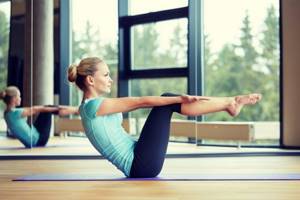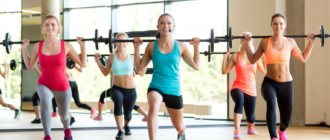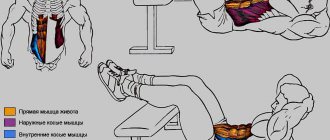Benefits of Strength Training for Weight Loss
The goals of a person losing weight are to reduce their size and increase the attractiveness of their figure.
To do this, he most often resorts to long-term aerobic exercise, such as running, cycling or swimming. Fear of strength training among those wishing to lose weight is primarily associated with an increase in muscle mass. However, they are the ones that will help increase basal metabolism, avoid re-accumulation of fat, draw beautiful muscle definition, and most importantly, move off the plateau in weight loss or training. The larger the muscles, the greater the amount of calories burned, even at rest. Strength training will not only help you burn a lot of energy during exercise, but it will also prime your body to burn more calories after your workout. Such exercises improve tendon strength, bone density, and form a muscle corset that provides postural support for the skeleton. And don’t be afraid to pump yourself up to the size of a professional athlete—it’s impossible to achieve this effect at home, without exercise equipment and sports nutrition to build muscles.
To master the correct strength training technique, it is better to contact a professional trainer, but there are situations when personal consultation and training in the gym are not possible. In this case, you need to create a program yourself, without using special equipment.
What type of workout to choose for weight loss?
Cardio exercises that provide aerobic exercise are the most effective for weight loss. They not only help burn fat deposits, but also form an attractive body contour; in the future, moderate exercise allows you to maintain the achieved results much better than dietary complexes.
Cardio training in combination with strength exercises gives good results, but not all exercises are aimed at losing weight, so it is recommended to create a program together with a trainer.
Circuit training rules
Strength exercises at home are most effective in a complex called circuit training. It includes up to 8 cycles of several sets of various exercises, the implementation of which is limited in time. The circuit training program includes working a large number of muscle groups. For novice athletes, it gives an excellent athletic effect, which helps to consistently lose weight.
A repetition is one exercise performed in a full cycle from contraction to stretching of the muscle being worked. Set (approach) - several identical repetitions in a row without a break.
The effect of circuit training depends on the number of repetitions:
- a set of 1-5 repetitions increases strength and muscle size, working with the maximum possible weight;
- a set of 6-12 repetitions balances strength, endurance, and muscle size;
- a set of 13-20 repetitions primarily develops endurance and has almost no effect on muscle size and strength, working with light or no weights.
For weight loss purposes, the second option is best - each set of 6-12 repetitions with a small additional load in the form of dumbbells, expanders, backpacks, etc.
Basic exercises
The basic group includes exercises of a general strengthening type, affecting several different muscles at once; these are the ones that people who are just starting to visit the gym should master and learn how to perform correctly.
The most effective basic exercises are reviewed and described below:
- Squats allow you to work your legs and work on the gluteal muscles, which is especially important if you need to get rid of excess weight: the tension of these muscle groups leads to the consumption of a large amount of energy, as a result of which the process of burning calories is stimulated. To do this, you need to master the correct technique: during squats, your legs should be shoulder-width apart, your elbows pulled back, your back tense, and your shoulder blades retracted. Often, squats are performed with a bar, which should be taken with a wide grip.
- The bench press allows you to provide stress to the chest muscles, while at the same time the development of triceps and deltoids occurs. When performing the exercise, the barbell must be lowered while inhaling, all movements must be smooth, and the bar must move only in the vertical plane. The barbell returns to its original position when exhaling, at which point it is necessary to bring the shoulder blades together and bend the back in the lumbar region.
- The deadlift is another basic exercise that burns calories efficiently; it is aimed at working the buttocks and spinal muscles. The exercise is performed from a squat, with the legs shoulder-width apart and parallel to each other. The grip on the bar should be wider than shoulder width, and your arms should be in a vertical position. All movements are made smoothly; When the bar reaches the level of your knees, you should straighten up, bringing your shoulder blades together.
- Crunches are basic exercises that primarily target the abs. The classic version is performed lying on your back with your legs bent at right angles, your hands are behind your head, and your elbows should be spread in different directions. When lifting the body to the pelvis, tension occurs in the abdominal muscles, movements should be smooth, and sudden jerks are not allowed. When the maximum point is reached, it returns to the starting position.
Types of strength exercises without machines
- Chest muscles - push-ups from the floor, with an expander or on parallel bars. Over time, you can add explosive exercises and weights to your wrists and ankles.
- Back muscles - pull-ups with your own weight. When the muscles get stronger and your own weight decreases a little, add a backpack with weights. The backpack is also used for deadlifts and abdominal pulls.
- Leg muscles - squats with a backpack, lunges (squatting on one leg), calf raises.
- Abdominal muscles - crunches, backpack press, bridges.
The plank is a strength exercise for a large number of muscle groups.
A strength training plan must necessarily include a warm-up: bending the head, torso, squats, lifting and bending the arms and legs. This stage is aimed at preventing sprains of tendons and ligaments.
To create a program for yourself, test your fitness level. Perform one set for different muscle groups, working each repetition as efficiently as possible. Divide the resulting number by two. Start from this. For example, you managed to do 8 push-ups, 10 pull-ups, 20 squats, 20 crunches, 20 calf raises, one circle of your workout at the initial stage may look like this:
- 4 push-ups.
- 5 pull-ups.
- 10 squats.
- 10 crunches.
- 10 calf raises.
There should be no pauses between exercises, and after completing the circuit, rest for 1 minute is required. Then repeat the circle. The number of laps can be increased to 5 with each workout, and then change the program a little by introducing new elements into it. The most difficult and time-consuming exercises are performed at the beginning of each circle.

Strength training without machines helps you use your body weight for good.
Training program
There are various options for training programs, including those aimed at eliminating fat deposits localized in certain areas of the body. The most popular and effective training schemes are discussed in detail below.
Circuit training
Many trainers recommend starting classes in the gym with circuit training - they evenly affect all muscle groups, but do not contribute to their growth, but to the moderate burning of fat reserves.
The basic principles of circuit training are as follows:
- Working out the muscles of the whole body in one day.
- Limiting the weight limit on exercise equipment to ensure high intensity.
- Repeat the circuits with little or no rest.
- Each circuit should include no more than 10 different exercises.
Any exercises aimed at working the muscles of the whole body are suitable for performing circuit training:
- Men are recommended to perform leg presses on special machines, deadlifts from a standing position, classic barbell lifts, manual bench presses, squats with additional weights, and classic push-ups.
- For women, various options for twisting, squats and lunges in different directions with weights in the form of dumbbells, lifting the upper and lower extremities from a lying position, performing the “Bicycle” exercise in a lying position, jumping and lying down with a hold are suitable.
Fitness program
A fitness program performed in the gym allows you to lose weight only if you normalize your diet to ensure a negative energy balance.
Classes involve 4 workouts per week; the fitness program for weight loss is described in detail below:
- On the first day after the warm-up, reverse crunches, squats and lunges using a barbell, presses and lower limb curls on the machine, hanging leg raises, and rows to the waist and chest on the machine are performed. All exercises are performed in 3 approaches, each with 10 to 15 repetitions. Additionally, classic crunches, hanging lower limb raises and crunches on a block simulator are performed: these exercises also require 3 approaches, the number of repetitions is maximum.
- On the second day , a warm-up is carried out again, after which a bench press and raises with weights are performed while lying on a bench, curls of the arms with weights and a load aimed at the biceps in a standing position, a seated dumbbell press, raises with weights while standing: all exercises require 3 approaches 12-14 repetitions. Triceps extensions in a lying position and on a special simulator are performed in 2 sets with 10-12 repetitions. Additionally, classic crunches and crunches are done on a block simulator: 3 approaches are performed with a maximum number of repetitions.
- On the third day, cardio training is practiced, which involves only aerobic exercise. For this purpose, jumping rope, cycling, brisk walking on a treadmill and training on elliptical trainers are suitable. Before such a workout, a warm-up is also required.
- On the fourth day, the training is carried out according to a similar scheme, only aerobic exercise is required.
Fat burning complex
An effective fat-burning complex for the gym will be interval training, including cardio training and strength exercises.
A similar weekly program is detailed below:
- On Monday , basic exercises are practiced aimed at working out the main muscle groups. Straight-legged barbell rows, lower limb presses on a machine, and lat pulldowns are repeated 8-10 times, for a total of 5 approaches. The seated dumbbell press and classic push-ups are done in 4 sets, requiring 10-12 and 8-10 repetitions, respectively. The workout ends with a plank, which also requires 4 approaches, the execution time is no more than a minute. Depending on how you feel, a break of 2 to 5 minutes is allowed between approaches.
- On Tuesday , a comprehensive cardio workout is carried out, it begins with a two-minute jog on the treadmill at the fastest possible pace, then the plank, burles and punches on the punching bag are done - a minute is allocated for all exercises. All the described exercises are carried out without breaks, in total you need to complete 4 similar circles, between which rests of 1 to 3 minutes are allowed.
- On Wednesday, a set of fat-burning exercises is performed with light weights. Suitable options include overhead pulleys with a wide grip, arm swings with weights in the form of a kettlebell, deadlifts on one straight leg, lifting onto a step platform and walking lunges with weights: a total of 4 sets of 10-12 repetitions are performed, the last exercise is performed on each leg separately. You can complete the workout by raising your lower limbs from a lying position: 4 approaches are done, each should include from 12 to 20 repetitions, depending on the degree of fatigue. A break of 1 to 4 minutes is allowed between all approaches.
- On Friday , supersets are performed that combine the upper and lower parts of the body. They include weighted squats with the legs as wide as possible and lat pull-downs, weighted lunges and lateral raises in a standing position, reverse crunches and lateral raises while bending, bending the lower extremities on a special machine and exercises on “Butterfly” simulator, body crunches in a supine position and a gluteal bridge on the floor, calf raises with weights and extension of the arms from behind the head. All supersets are performed in 3 sets of 10-12 repetitions, with a 2-3 minute break between them.
- On Saturday, only an hour of cardio training is carried out: running on a track at a moderate pace, cycling and elliptical training are suitable.
Power loads
Strength training is useful because it allows you not only to get rid of excess weight, but also to strengthen the musculoskeletal system, increase overall performance, develop and improve muscle tone, and improve health.
The most effective strength training is the following:
- Strength training according to the circuit described earlier in the article. For such classes, you can independently choose from 3 to 5 strength exercises aimed at working muscles from different groups: each of them is repeated 10-15 times, without breaks. Rest is provided only between sets; there should be 3-4 of them in total within one workout.
- Classes using the Tabata system, the essence of which is to repeat each exercise for 20 seconds, after which 10 seconds are given for rest. Once completed, the cycle is repeated 8 times, taking about 4 minutes in total, and during each hike you should strive to complete as many repetitions as possible. The technique allows you to effectively burn fat deposits and independently select the appropriate exercises; various types of presses and deadlifts, as well as squats with weights in the form of a barbell, are best suited.
Cardio training
Cardio training will be an effective addition to the main training program; you can practice it in the gym, at home or on the street.
The intensity is determined depending on the current body weight, physical fitness, fatigue rate, health status and the selected program.
Cardio training may include the following activities:
- Run outside in good weather.
- Run at different paces or briskly walk on a treadmill.
- Exercise bike classes.
- Exercises on step machines.
Split training
Split training helps you lose body fat while targeting several different muscle groups at the same time.
The three-day split program is described in detail below:
- On the first day, the following groups of exercises are performed: reverse crunches and crunches, weighted lunges and squats, weighted lower limb presses and weighted squats, seated dumbbell presses and standing lateral raises with weights. All exercises are performed in 3 sets of 10-15 repetitions, except for the leg press and weighted squats: they require 8-12 and 12-15 repetitions, respectively. As a warm-up and cool-down, exercise on an exercise bike is practiced for 10 minutes; between performing the listed groups of exercises, 10 minutes are spent running on the treadmill at a moderate pace.
- On the second day, it is necessary to perform the following groups of exercises: raising the lower limbs in a hanging position and reverse crunches, rowing the upper blocks with a wide grip and rowing the barbell to waist level when bending, rowing the upper and lower blocks, lifting the barbell in a standing position with bending the arms at the elbows and performing the Hammer exercise. For each named exercise, do 3 sets of 10-15 repetitions; Warm-up, cool-down and intermediate runs are carried out according to the same pattern as on the first day.
- On the third day , you will need to perform the following groups of exercises: dumbbell press on an incline bench and raises with weights on a horizontal bench, exercises on the Butterfly machine and dumbbell press on an incline bench, extension of arms with weights and press down on the upper block, lifting the barbell from the chest in a standing position and lifting dumbbells up in front of you. All exercises are performed in 3 sets of 10-15 repetitions; Weighted arm extensions and overhead pulley presses are performed for 8-12 and 12-15 repetitions, respectively. Warm-up, cool-down and intermediate runs are performed according to the same pattern as in previous days.
Exercise equipment
In modern gyms there are many different exercise machines; the following equipment is most effective for losing weight:
- The elliptical trainer is the main assistant in the fight against excess body weight. It is designed to simulate skiing or fast running; the machine is also suitable for cardio training. Another benefit is the minimal impact on the joints, making the exercise suitable for people who have recently suffered an injury.
- The treadmill is another classic weight loss device that is found in all gyms. Modern exercise machines allow you to adjust the angle of inclination and speed of movement to independently determine the appropriate workout intensity.
- Horizontal and vertical exercise bikes are similar in design to a regular bicycle, but without wheels. They are ideal for people experiencing problems with the musculoskeletal system caused by excess body weight.
- A stepper is a simulator for more intense exercise, providing increased loads and simulating climbing up stairs. Classes on it are recommended primarily for people who have problems with their knees or feet.
- The rowing machine provides a high degree of stress, so performing exercises on it is a difficult and exhausting process. Its advantages include a high degree of efficiency, maximum energy consumption and a low risk of injury, despite the complex design of the equipment.
- An expander, jump rope, dumbbells and other manual exercise equipment can effectively complement the main training program and diversify the set of exercises performed. The rotation disc and fitball also belong to the manual variety of exercise machines; they are recommended for people who want to eliminate excess fat deposits in the abdominal area.
Warm-up
A warm-up must necessarily precede any exercise in the gym for girls and boys, especially if you plan to perform strength exercises.
Its task is to warm up the muscles, which allows you to train at full strength and minimizes the risk of sprains and other injuries.
10-15 minutes are enough to warm up: during this time you can do squats and push-ups, go for a light jog, do a brisk walk on an inclined treadmill, or exercise at a moderate pace on any cardio machine.
Basic principles of home strength training for weight loss
Unlike cardio exercises, which are aimed at increasing endurance and working under long-term light loads, strength exercises increase the strength, volume and quality of muscle mass. To successfully lose weight while simultaneously forming a beautiful figure, you need to:
- Develop the maximum number of muscle groups. All muscles must be trained in a balanced manner to avoid overloading the musculoskeletal system, poor posture, and figure asymmetry. Giving preference only to those muscles in the area where the largest amount of fat is observed, you will not help reduce it only in this area.
- Get out of your comfort zone, regularly change the program, introducing new exercises. Manipulate the number of sets and repetitions to avoid the body adapting to the same loads. The more you like this or that exercise, the less effective it is.
- Use additional equipment and weights to develop muscles, using your own weight as much as possible.
- Focus on doing the exercise. Each exercise should be performed with maximum amplitude, and the weights should be selected in such a way that you can complete the prescribed number of repetitions to failure, but without pain.
- Restore. For weight loss purposes, 3-4 workouts per week with mandatory recovery periods are sufficient.
Exercises for problem areas
There are several problem areas on the body that are the most difficult to put in order.
Below are some effective exercises that can target these areas:
- You can put your triceps in order, but not over-pump them, by performing an exercise to straighten your arms in an incline position with weights. Do 2-3 sets of 20 repetitions, 3 times a week. The feeling of tension in the triceps after completing classes is a sure sign that the loads were selected correctly.
- Any variant of planks can effectively eliminate fat deposits from the abdomen, but it is better to start with planks on the forearms. The correct technique of execution involves the starting position as for classic push-ups, but the emphasis is placed on the floor with the elbows, and the body should be a straight line. Being in this position leads to tension in the back, buttocks, thighs and abdomen, which you should try to press to the lower back. The essence of the exercise is to hold the position and the achieved tension for a minute.
- Plie squats allow you to work your inner thighs. The technique is to move the pelvis back and lower the body down until the knee joints are bent at a right angle; after this, a smooth return to the starting position occurs. To get a positive result, you will need to perform 3 approaches, including 20-25 repetitions.









